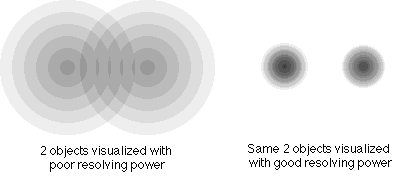Resolving Power
Claimed by estaniforth3
The Main Idea
Resolving power is the measure of an optical system's ability to differentiate between the images of objects close together or separate similar wavelengths of radiation and therefore display fine detail. In an ideal situation, this quantity is dependent on two components of the radiation, the aperture (the space through which light passes in an optical system) and wavelength (the distance between crests in a wave). However in real life applications the resolving power is limited by the effects of diffraction, the effect on a wave when it encounters an obstacle.
The Rayleigh Criterion for Minimal Image Resolution
Lord Rayleigh (John William Strutt) determined that, given two point light sources, the center of the image of the first source will fall on the first diffraction ring of the second source. Because of this, there is a minimum angle (in radians) between the two sources (as viewed by the system) for the two sources to be at least marginally resolvable (distinguishable). In ideal circumstances it would be defined as [math]\displaystyle{ \frac{λ}{a} }[/math], however factoring in diffraction:
Angular limit of Resolution [math]\displaystyle{ = \frac{1.22λ}{a} }[/math]
λ - wavelength in meters, [math]\displaystyle{ a }[/math] - diameter of the aperture in meters
The resolving power can be found by calculating the inverse of hte angular limit of resolution.
Resolving power [math]\displaystyle{ = \frac{a}{1.22λ} }[/math]
λ - wavelength in meters, [math]\displaystyle{ a }[/math] - diameter of the aperture in meters
A Computational Model
How do we visualize or predict using this topic. Consider embedding some vpython code here Teach hands-on with GlowScript
Examples
Be sure to show all steps in your solution and include diagrams whenever possible
Simple
Middling
Difficult
Connectedness
- How is this topic connected to something that you are interested in?
- How is it connected to your major?
- Is there an interesting industrial application?
History
Put this idea in historical context. Give the reader the Who, What, When, Where, and Why.
See also
Are there related topics or categories in this wiki resource for the curious reader to explore? How does this topic fit into that context?
Further reading
Pedrotti, Frank L., Leno M. Pedrotti, and Leon S. Pedrotti. Introduction to Optics, 3rd ed. San Francisco: Addison Wesley, 2007.
Serway, Raymond A., Jerry S. Faughn, Chris Vuille, and Charles A. Bennet. College Physics, 7th ed. Belmont, Calif.: Thomson Brooks/Cole, 2006.
Young, Hugh D., and Roger A. Freedman. University Physics, 12th ed. San Francisco: Addison Wesley, 2007.
External links
Internet resources on this topic
References
"Optics." Encyclopedia of Physical Science. Facts On File, 2009. Science Online. Web. 2 Dec. 2015. <http://online.infobase.com/HRC/LearningCenter/Details/8?articleId=299135>.
